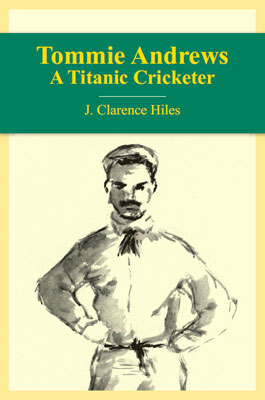
ISBN 0954589238
Softback, 192pp.
Price: £15.00
Hiles sets the biography of the most famous shipbuilder in history in Comber, the home of the Andrews family, and traces the childhood of young Tommie Andrews from his birth at Ardara House, to Inst School, cricket at The Green and ultimately his meteoric rise to fame at Harland and Wolff Shipyard.

The story is of considerable historical interest as very little has previously been known about Thomas Andrews (Jun) other than a small book written by Shan Bullock several months after the Titanic sinking in 1912. The book finishes with the Titanic Story, but from a Tommie Andrews perspective and deals with the huge legacy his death has left in the town and country of his birth.
From all accounts Tommie Andrews was a lovely man, a pillar of society and the Non-Subscribing Presbyterian Churches in Comber and Rosemary Street in Belfast. He was a modest cricketer, who played with and against all the best cricketers in Ulster during the embryonic years of NCU and North-West Cricket in 1880 and afterwards.
Tommie made his 1st XI debut as a raw 15 year-old and played his last game for the club in 1904 when his commitments to shipbuilding consumed his life. He was a Vice-President of the Northern Cricket Union and although he declined the Presidency on several occasions because of work, it was always expected he would don the role at some stage later in his life. He played in three Junior Cup winning teams and amongst his 1st XI achievements was a top score of 66 against Lisburn in the Senior Cup in 1901.
Tommie lived his life to high principles and in the face of adversity Hiles portrays the story of a heroic man doing all that he could to save women and children from the sinking ship. He died a hero and this biography will give him a unique place in the history of local cricket because, as Hiles claims, he was surely "the most famous person to play cricket in Ireland."
Clarence Hiles has produced another cricket masterpiece that ticks all the boxes if your cricket passion is combined with the Titanic story and local history.
It is certainly an ideal Christmas present and at 15 quid it is a pinch for a book of this type.
Hiles sets the biography of the most famous shipbuilder in history in Comber, the home of the Andrews family, and traces the childhood of young Tommie Andrews from his birth at Ardara House, to Inst School, cricket at The Green and ultimately his meteoric rise to fame at Harland and Wolff Shipyard.
The story is of considerable historical interest as very little has previously been known about Thomas Andrews (Jun) other than a small book written by Shan Bullock several months after the Titanic sinking in 1912.
The book finishes with the Titanic story, but from a Tommie Andrews perspective and deals with the huge legacy his death has left in the town and country of his birth.
From all accounts Tommie Andrews was a lovely man, a pillar of society and the Non-Subscribing Presbyterian Churches in Comber and Rosemary Street in Belfast.
He was a modest cricketer, who played with and against all the best cricketers in Ulster during the embryonic years of NCU and North-West Cricket in 1880 and afterwards.
Tommie made his 1st XI debut as a raw 15 year-old and played his last game for the club in 1904 when his commitments to shipbuilding consumed his life.
He was a Vice-President of the Northern Cricket Union and although he declined the Presidency on several occasions because of work, it was always expected he would don the role at some stage later in his life.
He played in three Junior Cup winning teams and amongst his 1st XI achievements was a top score of 66 against Lisburn in the Senior Cup in 1901. Tommie lived his life to high principles and in the face of adversity
Hiles portrays the story of a heroic man doing all that he could to save women and children from the sinking ship.
He died a hero and this biography will give him a unique place in the history of local cricket because, as Hiles claims, he was surely "the most famous person to play cricket in Ireland."